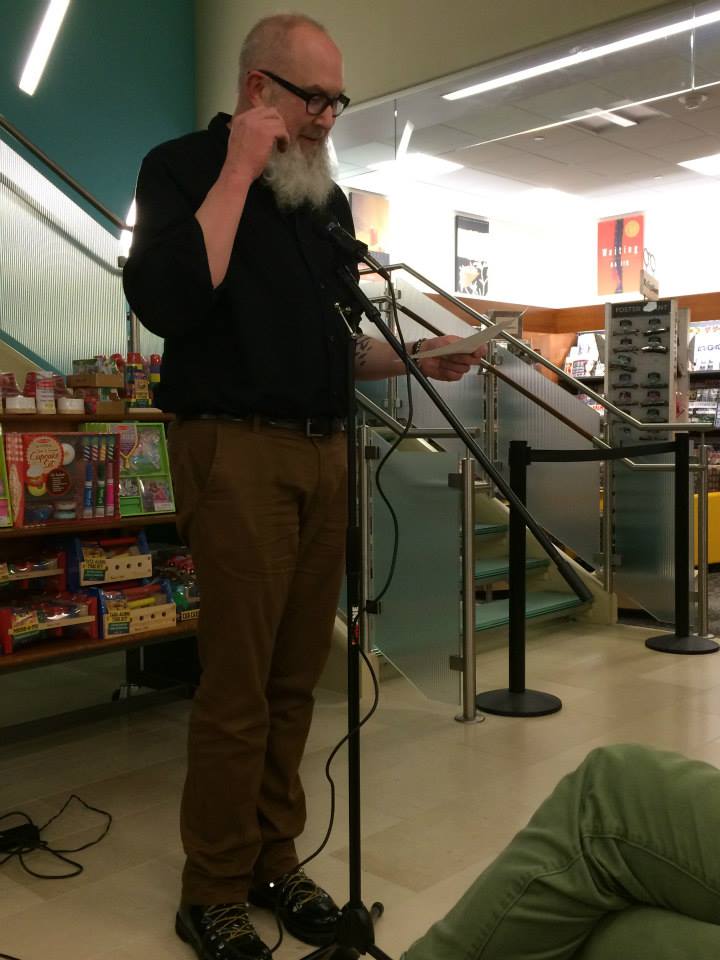
Bruce Covey doing introductions at a “What’s New in Poetry?” reading
Bruce Covey, publisher and editor at Coconut Books, recently announced the closing of “What’s New in Poetry?,” a reading series organized by Covey at Emory University in Atlanta. The series ran for 12 years, co-hosted by Coconut Magazine’s senior editor, Gina Meyers, from 2011-2014, and brought over 300 new and emerging poets to students at the university. Covey recently shed some light on the beginning and end of an expansive venture in contemporary poetry.
Nick: What drove you to start ‘What’s New in Poetry?’
Bruce: At the time, I was teaching Creative Writing at Emory, and the Program brought only 1-2 poets per year to campus, all of whom were recognized and widely lauded figures. More than once my students told me about the distance they felt from these readers–they couldn’t imagine what had to happen for them to get from point A (where they were at the moment) to point B (e.g., winning a Pulitzer Prize). Also at the time there wasn’t much of an independent reading scene in Atlanta–a pretty established slam series, but not much else. I wanted to start a series that focused on writers with 0-2 books that took place in the Emory residence halls–bringing poetry to the students on their own terms and in their own homes. In addition to these younger writers, I wanted to feature more established small press and experimental writers, so students could be exposed to a wide range of aesthetics (the Creative Writing department as a whole tended to favor very traditional poets). In every case, I asked writers to hang around after the readings just to talk with students. Pretty soon after that, the series started to draw poets from the Atlanta community. And not long after that our audience expanded to 70-100 per event.
N: Is there a reading that sticks out in your mind, for whatever reason, as remarkable? A particular poet? A moment?
B: Honestly, I really loved all of our readers and readings–I love poetry readings, and everyone has been wonderful. But meeting Ron Padgett for the first time was wonderful. He was one of the first two poets (along with Ted Berrigan) I’d read and liked (in high school). It’s the most nervous I’d been before a reading, but Ron was incredibly nice and gave an incredible reading–totally humble and funny and powerful as his work always is. But we’ve had a lot of terrific moments.
N: Do you think the closing of the series will be a blow to the poetry community at Emory? In Atlanta?
B: I guess so? I mean, Atlanta has some great and relatively recent reading series that have already and will continue to bring awesome poets to town. And I’m not sure how much we remained on Emory’s radar after I stopped teaching & after Harmony Neal and Molly Brodak left as fellows–even though the series took place on campus, we didn’t draw many students over the past two years. The gap we leave is probably one of volume (we brought more than 70 readers last year) and the fact that we could pay each reader–something I was always proud of. That said, I’m not worried about poetry thriving in Atlanta–it will continue to do so, and I’ll still be around with Coconut and other things.
The final events in the series are listed on Facebook. A large portion of “What’s New in Poetry?” readings can be listened to and downloaded for free via iTunes. Links to this material and a full archive of the series’ past events can be found at the Emory Poetry Council webpage.
Also, Coconut Magazine’s submission period is currently open! Head over to their site for more details.

